Science on Stage: a Slovak-British relationship Inspire article
For two science teachers from opposite ends of Europe – David Featonby and Zuzana Ješková – Science on Stage was the beginning of an inspiring and enjoyable collaboration.
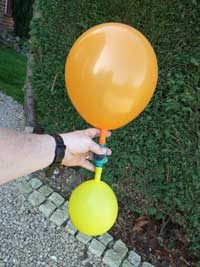
Our collaboration began in 2009, when David ran a workshop entitled ‘What Happens Next?’ at the Science on Stage teaching festivalw1 in Berlin, Germany. There, he challenged the participants to predict the results of simple experiments that have unusual outcomes (Featonby, 2007).
Zuzana was particularly intrigued by one experiment – the ‘two balloons surprise’ (figure 1) and decided to investigate it further with her students back home in Košice, Slovakia. Correspondence flowed between the UK and Slovakia as we modified the experiments and explored more ideas (Ješková et al., in press).
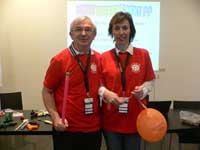
their workshop at Science on
Stage 2011 in Copenhagen
Image courtesy of Zuzana
Jeskova
As a result of our correspondence, we developed and led a joint ‘What Happens Next?’ workshop at the 2011 Science on Stage international science teaching festival in Copenhagen, Denmark, sharing our new experiments and results with teachers from 27 European countries.
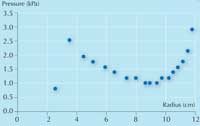
surprise’. What happens
when the tap is opened? The
small balloon blows up the
bigger one, but why? The
graph gives a clue: the air in
the smaller balloon – which
has a radius of 3-4 cm – is
(counter- intuitively) at a
higher pressure than that in
the larger one, which has a
radius of 6-8 cm. To equalise
the pressure, the air rushes
from one balloon to another.
It is also possible for a larger
balloon that has been
inflated to near its maximum
size to inflate a smaller
balloon (Featonby, 2009;
Ješková et al., in press).
Click on graph to enlarge
Images courtesy of David
Featonby
Science on Stage festivals offer a unique opportunity for teachers from across Europe to share their experiences and develop new ideas, and it doesn’t have to stop when the participants return home – as we demonstrated. To encourage even more effective exchange of ideas, participants from the 2011 festival could apply for travel scholarships so that teachers from one country could share their ideas and skills with larger groups of teachers elsewhere. We successfully applied, and in March 2012, David flew to the University of PJ Šafárik in Košice to run a workshop with Zuzana for Slovakian physics teachers.
The workshop was part of a Slovakian teacher-training course, ‘Inquiry activities in physics education’, which was inspired by Science on Stage and encourages the use of interesting and stimulating ideas, experiments and projects in teaching. Through lectures and workshops, excursions to research sites and independent activities, the participants develop their own ideas for motivating and attracting students to science.
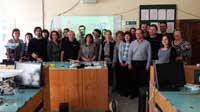
a group of enthusiastic
Slovak teachers
Image courtesy of David
Featonby
After 40 hours of direct learning and 25 hours of distance learning spread over the academic year, each participant develops a project to trial at his or her school. The course is planned to be run each year in Košice. The best ideas will be selected for the Slovakian national Science on Stage festivalw2. There, some of them may even be chosen to be a part of the international festival.
During the workshop in March, we challenged participants to predict ‘What Happens Next?’. The experiments, which use everyday equipment, were chosen to highlight misconceptions and to develop thinking skills.
In many ways, this put the teachers in the position that students often find themselves in – that of being unsure of the answers. Puzzling outcomes were then discussed; many of the Slovak teachers spoke English, but Zuzana was on hand to translate if necessary. Some of the experiments are detailed below, others can be found in Featonby (2007).
Balanced spoon
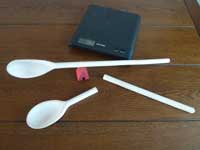
spoon weigh the same? The
centre of mass of the head is
nearer to the pivot than that
of the spoon´s handle.
Applying the principle of
moments in equilibrium, the
head must weigh more
Image courtesy of David
Featonby
Balance a wooden spoon at its centre of mass. Then cut the spoon at that point and weigh the two halves. Which is heavier, or do the pieces weigh the same?
Backwards clock
What happens to a backwards clock when we look at its reflection in the mirror?

Images courtesy of David Featonby
Floating orange
On a balance, place an orange with a glass of water beside it. What is the reading? Next place the orange in the glass, so it floats without touching the sides. Does the reading on the balance stay the same, increase, or decrease?
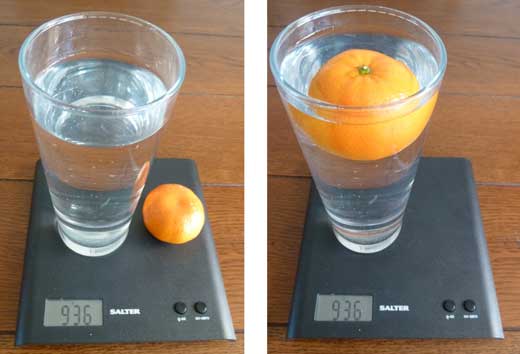
reading does not change. This is because the same material is on the balance. The apparent loss in
mass of the orange is compensated by the weight of water it displaces: the upthrust on the
orange has a consequent downthrust on the water
Finger in water
Place a glass of water on a balance and note its mass. Lower your finger into the water without touching the sides. What happens to the mass this time?
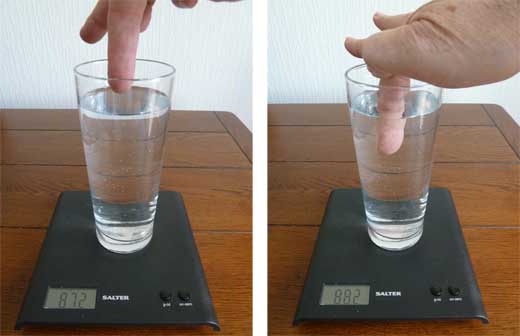
result of buoyant force acting on your finger
Images courtesy of David Featonby

Our Slovak-British exchange was beneficial not just to the participants on the course. Both of us learned from our collaboration, developing further ideas for experiments and co-operation, and also discovering different national approaches to teaching and teacher training.
And to our surprise, we realised that the challenge of explaining ideas in a foreign language can actually help make the explanations clearer. We found that international co-operation between science teachers can greatly enrich the quality of teaching – and also form the basis of long-lasting friendships.
References
- Featonby D (2007) What happens next? A teaching strategy to get students of all ages talking. Science in School 7: 24-27.
- Featonby D (2009) Balloons hold the key to inflation. Physics Education 44: 344. doi: 10.1088/0031-9120/44/4/F05
- Ješková Z, Featonby D and Feková V (in press) Balloons revisited. Physics Education
Web References
- w1 – Science on Stage is a network of local, national and international events for teachers, initially launched in 1999 by EIROforum, the publisher of Science in School. At each national Science on Stage event, a delegation of teachers is selected to represent their country at the Science on Stage international teaching festival. The next international festival will be held on 25-28 April 2013, in Słubice-Frankfurt (Oder) on the Polish-German border. During the festival, 350 teachers from 27 countries will share their most innovative teaching ideas in workshops, on-stage performances and the teaching fair.
- Participation is free for delegates. For other science teachers, there will be a limited number of places for which a registration fee will be charged. See the Science on Stage Europe website for details.
- Science on Stage was launched in 1999 by EIROforumw4, the publisher of Science in School.
- w2 – Science on Stage Slovakia offers online information about the organisation in Slovak.
- w3 – The Institute of Physics is a UK-based society that promotes physics. The society provides resources for schools, including professional development courses for teachers, student careers resources and high-quality teaching materials.
- w4 – EIROforum is a collaboration between eight of Europe’s largest inter-governmental scientific research organisations, which combine their resources, facilities and expertise to support European science in reaching its full potential. As part of its education and outreach activities, EIROforum publishes Science in School.
